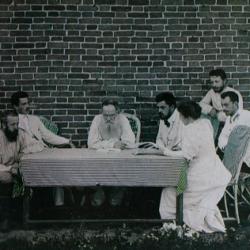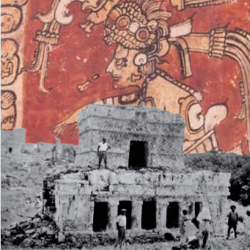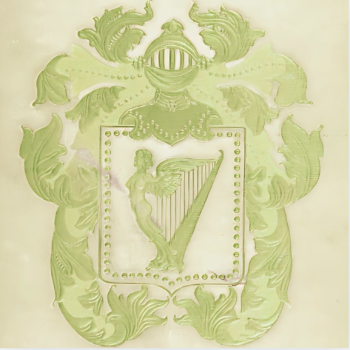WHEN THE LEVEE BREAKS
During the second week of August, Johnston was feeling ill. On August 9, 1889, he wrote a letter to his father admitting the possibility of “a permanent breakdown in health,” and asking him to look out for a post in England or Ireland “during the next year.”[1]
August 28, 1889, marked the first day of the Muslim month of Muharram (the first month of the Islamic year. Hijrī calendar: 1 Muharram 1307.) For Shia’s, the first ten days of Muharram were devoted to ceremonies of remembrance for the martyrdom of Husain, the second son of Ali and Fatima. In an observance unique to Murshidabad, the Shias also mourned the death of Hassan (though Hassan’s death occurred ten years before the death of Husain.) Every evening during Muharram a small procession comprised of the leading Shia was formed and passed by the strand amidst a candle-light illumination to music played by the Nawab’s band.[2] The Nawab invited Johnston, Vera, and Eugène to Hazarduari Palace to witness the Roz-i-Qatl procession. In the intervening days, Murshidabad would be experience a devastating natural disaster. Though the country was protected by an embankment, “it was always a question whether the earthwork was secure,” during the height of the monsoon. On August 30, 1889, the Bhagirathi River rose to an unprecedented height and the embankment at Berhamganj (between Lal Bag and Berhampore) gave way. The following day the flood waters began to run into the Motijhil, Amaniganj, and Lal Bag.
Ritchie and the Civil Servants procured a light boat and traveled down the wide current flowed over the district, but they got caught among the trees and their boat sank. With “no prospect of deliverance,” they made a line with their hands and worked their way to safety by “hanging on to trees through the flood, which was running swiftly, to the high land.”[3] Another breach occurred on September 1, 1889, near the town of Rampal, three miles above Lalitakuri. Seven men were arrested in connection with the breach at Rampal, but the damage was already done. In total, between the two breaches, eight hundred feet of embankment had given way. The water from the breach at Rampal flooded many villages along its course to Murshidabad and left a trail of debris from the pucca and kucha houses in its wake. The rice fields were beneath six-feet of water, and all the principal roads in the city of Murshidabad were submerged. The ground about the Nawab’s garden-house, the Humayon Munzil, was one sheet of water. The flood eventually cut away the bank below Hazarduari Palace. It was feared that if the embankment near the neighboring distillery building gave way, then the destruction of Murshidabad City would be complete. Johnston, Ritchie, Meares (District Superintendent,) Livesay (Executive Engineer,) and Kumar Ranajit Sinha (Vice-Chairman of the Municipality,) raced to the imperiled embankment to see what could be done. Livesay, aided with coolie labor, was able to block the mouth of the culvert, and construct another bund.[4] Ritchie writes:
I had an anxious time in the district with floods. The country was protected by an embankment, but in the height of the rains it was always a question whether the earthwork was secure. In 1889 the river rose to an unprecedented height, and the bunds1 gave way. I had a great deal of boating, and got three duckings in the river in a week. When the first breach in the embankment occurred, I got a light boat and went down the broad current flowing over the country quickly, but we got caught among the trees and our boat sank. I sat with the boatman on a babal-tree; but, as there was no prospect of deliverance, we made a line with our hands and worked our way hanging on to trees through the flood, which was running swiftly, to the high land. Sir Steuart Bayley came to see what we officials were doing, and, as we were returning in the night to our launch, I missed my footing in the darkness and went plump into the river. Somebody caught hold of me as I was swept by and hauled me in. Sir Steuart had a long day and finished up at Moorshedabad. We drove out with the Nawab, looking like a paroquet dressed in grey silk, in a shut carriage to see the floods. The rain was coming down and presently the water flowed all round us and into the carriage, and we stuck fast—an absurd experience. I had a month’s boating over the flooded track. The village sites stood above flood-level, and on these were crowded together the villagers and cattle, while the rest of the country was submerged. The Government of India formally thanked me for my flood work. For me it was a jolly open-air holiday, and the deposit of silt enriched the soil so much that the cultivators were not to be pitied overmuch.[5]
September 4, 1889, was the eighth day of Muharram (8 Muharram 10, 1307,) a day when the Nawab traditionally “put on the chains of humiliation,” and distributed “purses to persons in real distress.”[6] All of Murshidabad qualified. The Nawab created a relief committee consisting of Fazl Rubbee, Janaki Nath Paure, and the Sub-Divisional Officer of Lalbagh. The Nawab placed a subscription for Rs. 3,000 at their disposal. Maharani Swarnamoyee contributed another Rs. 1,000. Additionally, the Nawab sheltered as many of the displaced population as he could in the Nizamat buildings and stables, and distributed rice, dal, salt, and mustard oil on his boats and elephants to the afflicted villages. On September 6, 1889 (10 Muharram 10, 1307) the Nawab invited Johnston, Vera, and Eugène to witness the Roz-i-Qatl procession.[7]
← Table Of Contents →
SOURCES:
[1] Guinness, Selina, “Ireland Through The Stereoscope: Reading The Cultural Politics Of Theosophy In The Irish Literary Revival.” in Betsey Taylor FitzSimon and James H. Murphy (ed.,) The Irish Revival Reappraised. Four Courts Press. Dublin, Ireland (2004): 19-32.
[2] Ich Dien. “Religious Endowments And Charities Of Bengal Zemindars.” The Calcutta Review. Vol. CXII, No. 223. (1901): 50-77.
[3] Ritchie, John Gerald. The Ritchies In India: Extracts From The Correspondence Of William Ritchie, 1817-1862. J. Murray. London, England. (1920): 369.
[4] “Disastrous Flood At Moorshedabad.” Civil & Military Gazette. (Lahore, Pakistan) September 4, 1889; “The Alarming Floods At Murshidabad.” The Englishman’s Overland Mail. (Calcutta, India) September 7, 1889; “Breach Of The Laltakuri Embankment.” The Englishman’s Overland Mail. (Calcutta, India) September 7, 1889; “The Moorshedabad Floods.” Civil & Military Gazette. (Lahore, Pakistan) September 9, 1889; “Moorshedabad Floods.” The Englishman’s Overland Mail. (Calcutta, India) September 17, 1889; “Bengal.” The Madras Weekly Mail. (Madras, India) October 2, 1889; “Notes—British India.” Colonies And India. (London, England) October 2, 1889; Johnston, Charles. “A Holy Man: Helping to Govern India.” The Atlantic Monthly. Vol. 110, No. 5. (November 1912): 653-659.
[5] Ritchie, John Gerald. The Ritchies In India: Extracts From The Correspondence Of William Ritchie, 1817-1862. J. Murray. London, England. (1920): 369.
[6] Majumdar, Purna Chundra. The Musnud Of Murshidabad (1704-1904): Being A Synopsis Of The History Of Murshidabad For The Last Two Centuries. Saroda Ray. Murshidabad, India. (1905): 61.
[7] Walsh, J. H. Tull. A History Of Murshidabad District (Bengal): With Biographies Of Some Of Its Noted Families. Jarrold & Sons. London, England. (1902): 67.













